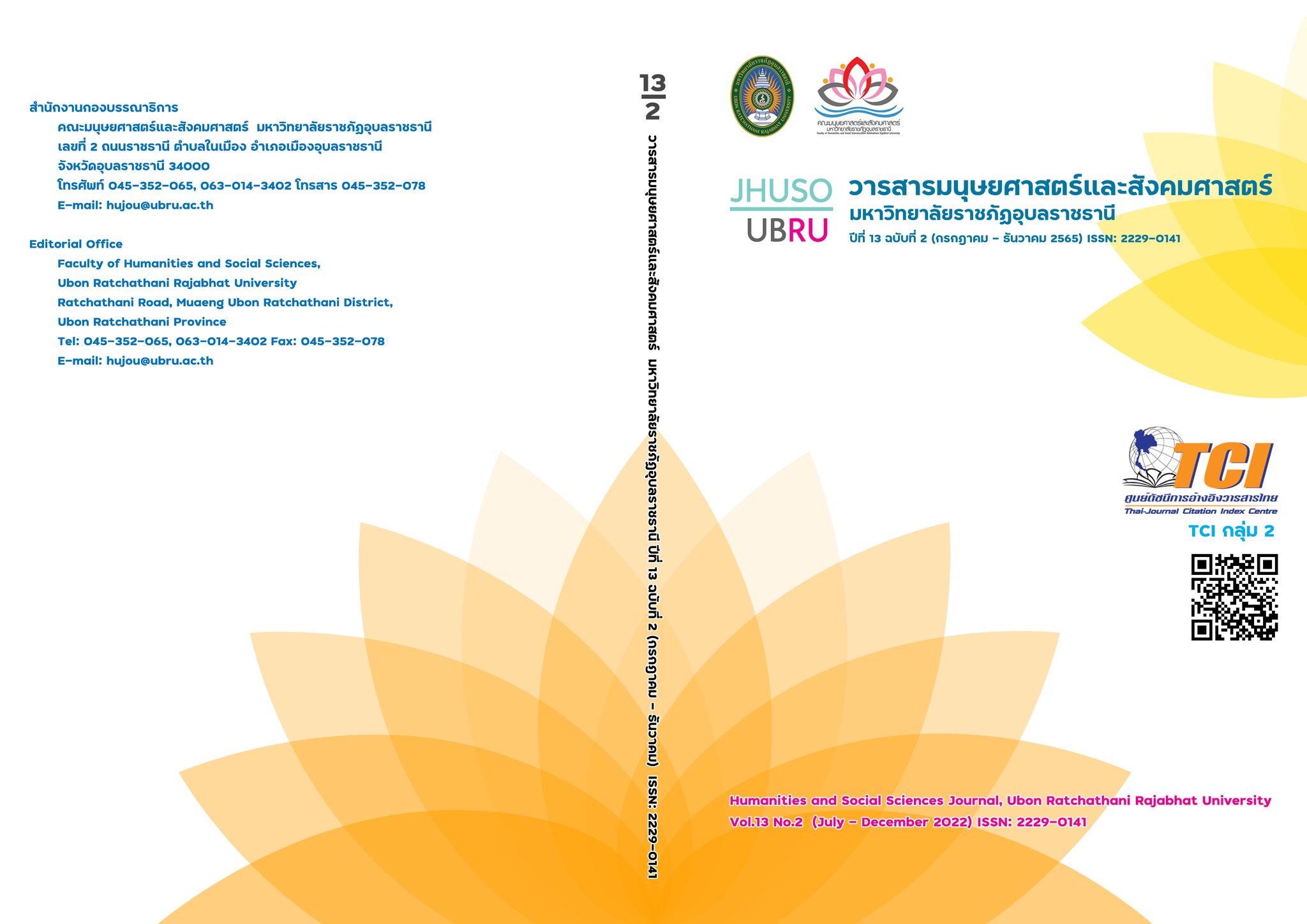ความแตกต่างทางภาษาศาสตร์ที่มีผลต่อการแปลภาษาไทยเป็นภาษาอังกฤษ: ข้อมูลเชิงปริมาณจากกรณีศึกษานักศึกษาชั้นปีที่ 3 มหาวิทยาลัยราชภัฏอุบลราชธานี
Main Article Content
บทคัดย่อ
ตัวอย่างการใช้จากภาษาสำหรับกลุ่มสำหรับภาษาไทยสำหรับภาษาต่างประเทศ (EFL)
สามารถทำได้โดยผ่านกระบวนการทักษะการผลิตภาษา เช่น จะขอถามหรือสละคำถามนี้รวมถึง
วิธีการเขียนและแปล เพื่อศึกษาว่าท่านหรือผู้รับอนุญาตนั้นเกิดจากสาเหตุใดที่ทำให้ทาง
ภาษาศาสตร์ระหว่างภาษาอังกฤษและภาษาไทยมีซุบซิบเบื้องต้นที่กลุ่มภาษาไทยพบญาติในทารกแรกเกิด
คือนักศึกษาในชั้นปี 3 จำนวน 138 คน ในบางครั้งต้องมีภาษาไทย 2 โดยทำ
มาให้กลุ่มผู้ใช้ทดสอบเพื่อคละอันที่มีข้อกำหนดในการกำหนดระยะเวลาการเรียนรู้ร่วมกันเพื่อดาวน์โหลด เครื่องมือการ
วิจัยคือเรื่องสั้นที่แปลเป็นภาษาไทยแล้วโดยผู้ทำการวิจัยนำไปใช้เป็น งานกลุ่มกับสถิติใน
ระยะเวลา 8 สัปดาห์ เพื่อวิเคราะห์งานภาษาไทยที่ต้องใช้บันทึกผล ซึ่งจัดกลุ่มตัวอย่างและนำเสนอ
เป็นอัตราที่มอบให้โดยนำไปใช้กับโปรแกรม (Error Analysis) ผลลัพธ์ของการวิจัยที่ตรวจพบที่พบ
ส่วนใหญ่จะประกอบด้วย Text ด้านรูปของคำที่เรียกใช้ และการใช้คำนำหน้าคำนาม ซึ่งรวมถึง Article
ผลการวิจัยที่ ได้อาจจำเป็นต้องมีความรู้เพิ่มเติมด้านอื่นๆ ในเนื้อหาที่ต้องเรียนก่อนหรือ
มีคำถามซึ่งต้องเรียนรู้พร้อมกันกับโปรแกรมนี้ในหลักสูตรภาษา
ไทย
Article Details

อนุญาตภายใต้เงื่อนไข Creative Commons Attribution-NonCommercial-NoDerivatives 4.0 International License.
เอกสารอ้างอิง
Kaewnuch, S. & Boonsue, W. (2013). Thai Students’ Ability in Analyzing Syntactic Errors: A Case Study from an English Error Analysis Class. Retrieved 10 January 2020, from: https://www.academia.edu/5579281/Thai_Students_Ability_in_Analyzing_Syntactic_Errors_A_Case_Study_from_an_English_Error_Analysis_Class.
Kobsiriphat, W. (2005). Translation: A Linguistic Approach. Mahasarakham: Mahasarakham University.
Kohdtkam, P. (2016). Error Analysis of an English Descriptive Essay: A Classroom Research in a Diverse Setting of Second-Year Weekend Students, Ubon Ratchathani Rajhabhat University. Humanities and Social Sciences Journal, Ubon Ratchathani Rajabhat University, 7(2), 303-323.
Golkova, D. & Hubackova, S. (2014). Productive Skills in Second Language Learning. Procedia – Social and Behavioral Sciences 143 (2014), 477-481.
Lennon, P. (2008). Contrastive Analysis, Error Analysis, Interlanguage, from Gramley S. & Gramley V. (eds), 2008. Bielefeld Introduction to Applied Linguistics, 51-60. Bielefeld: Aisthesis.
Lightbown, P. M. & Spada N. (2006). How Languages Are Learned, 3rd ed. Oxford: Oxford University Press.
Mahamongkol, N. (2006). Error Analysis of the Writing of First Year Students Taking Course 0115102 English II, Academic Year 2005, Thaksin University. Songkhla: Thaksin University.
Mongphet, S. H., J. & Singhasiri, W. (2009). Appropriateness of Vocabulary Chosen from Thai-English Electronic Dictionaries in Writing. Proceedings of the ASIALEX 2009 “Dictionaries in Education,” August 20-22, 2009, 6th Biennial Conference of the Asian Association for Lexicography (pp. 1-14) [P020]. Bangkok: King Mongkut’s Institute of Technology Ladkrabang.
Rustipa, K. (2011). Contrastive Analysis, Error Analysis, Interlanguage and the Implication to Language Teaching. Ragam, Jurnal Pengembangan Humaniora, 11(1), 16-22.
Surasit, N. (2007). Techniques for Translation. Bangkok: P.S. Press.
Tangpermpoon, T. (2007). An Analysis of Lexical Errors by Thai Writers of English. Thai TESOL Bulletin, 20(1-2), 25-45.
Yumanee, C. & Phoocharoensil, S. (2013). Analysis of Collocational Errors of Thai EFL Students. Language Education and Acquisition Research Network (LEARN) Journal, 6(1), 90-100.
Zaki, M. (2015). Implications of Contrastive Analysis and Error Analysis on Second Language Acquisition. DOI: 10.13140/RG.2.1.5184.4960. Retrieved 3 June 2018, from: file:///C:/Users/HP/Downloads/implicationsofCAandEAonSLA.pdf.


